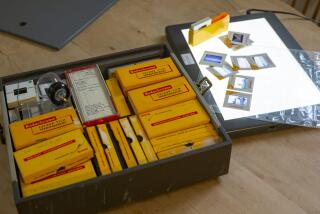Using light, scientists make bad memories good in mice
Can a bad memory be turned into a good one? Scientists say they’ve been able to do just that in a group of mice by activating certain parts of their brain with light.
The findings in the journal Nature show that memories can potentially be modified without drugs or extra training -- simply, if that’s the word, by breaking the memory into its components in the brain and rewiring the faulty connection.
You might think of memory as something fixed, a historical recording that’s as unchangeable as the past. That’s far from reality, senior author Susumu Tonegawa of the Massachusetts Institute of Technology said in a news briefing.
“Recording memory is not like playing a tape recorder, but it is a creative process -- sometimes even leading to an entirely false memory,” Tonegawa said.
After all, a family vacation in the Bahamas is a very positive memory -- unless there’s a swimming accident, which could suddenly make that same happy time seem like a very negative one.
Memory, then, is malleable. And a single memory isn’t stored in just one place in the brain. The context of a particular memory -- where it took place, what happened -- seems to be coded in a part of the brain called the hippocampus. But that same memory’s emotional valence -- how positive or negative that experience felt -- is actually coded in a different region of the brain called the amygdala.
To take advantage of this division, the researchers took two groups of male mice that had been genetically modified so that neurons in the hippocampus and amygdala would respond to light. They exposed one of the groups to an unpleasant experience (small electric shocks to their feet) and gave another group a pleasant experience (some hangout time with female mice).
Later, when the male mice were hanging out in a particular corner, the researchers shone blue light to reactivate the same neurons that had just learned from that bad (or good) experience. The mice who’d gotten the shock treatment fled from the blue light, while those who had hung out with the female mice lingered and basked in the glow.
Could those bad memories be switched to good ones -- and vice versa? In a second set of experiments, researchers gave the bad-memory mice some pleasant private time with the female mice. At the same time, the researchers shone blue light at the mice, which artificially activated the old foot-shock neurons.
But this time, rather than running away, the mice started reacting positively to the blue light. (The opposite happened with the mice who’d hung out with the female mice first and gotten shocked later.)
Here’s what researchers think is happening in the brain: In the amygdala, the positive response to the female mice was overriding the negative response to the artificially activated shock memory. The neurons weren’t being rewritten -- the negatively responding amygdala neurons were still there. But the hippocampus neurons were now starting to form connections with the positively responding amygdala neurons instead. The experiment didn’t overwrite the cells; it rerouted the connections between them.
There are limits to the researchers’ light-driven technique, researchers Tomonori Takeuchi and Richard G.M. Morris of the University of Edinburgh, who were not involved in the paper, wrote in a commentary. That’s particularly true when a memory is linked to a series of neuron firings -- like a musical tune.
But, they added, “molecular engineering is nonetheless shedding light on our understanding of the underlying physiological networks of memory.”
Remember, follow @aminawrite for more fascinating science news







